Continuation War
Continuation War
Part of: World War II

Assault gun III Ausf. G of the Finnish Army (1943)
1 German-Finnish-Italian flotilla (Laivasto-osasto K) on Lake Ladoga.
2 A British air raid on Petsamo on 31 July 1941.
![]()
This article or subsequent section is not sufficiently supported by evidence (e.g., anecdotal evidence). Information without sufficient evidence may be removed in the near future. Please help Wikipedia by researching the information and adding good supporting evidence.
Continuation War (Finnish jatkosota, Swedish fortsättningskriget) refers to the war fought between Finland and the Soviet Union during World War II as a continuation of the Finnish-Soviet Winter War (November 1939 to March 1940) from 22 June 1941. In this war, Finland initially succeeded in recapturing the territories lost to the Soviet Union during the Winter War, alongside the German Reich. Afterwards, a three-year-long war of position developed, until the Soviet Union started a big offensive in June 1944, as a result of which an armistice was concluded. Content of this armistice of Moscow was not only the loss of the reconquered, but also the cession of further Finnish territories to the Soviet Union. Part of the treaty was also the obligation of Finland to attack the German troops still in the country, which led to the Lapland War and the withdrawal of the German troops from Finland. A peace treaty was not reached until the Paris Peace Conference of 1946.
Initial Situation
In 1939, the Soviet Union and the German Reich divided Europe into spheres of interest in the Molotov-Ribbentrop Pact. After its conclusion, both countries pursued a policy of expansion within these spheres. Germany attacked Poland on September 1, thus beginning World War II. On September 17, the Soviet Union followed suit and occupied the part of Poland promised to it in the treaty. In the summer of 1940, the Soviet Union extorted Bessarabia from Romania and annexed the Balticstates. Before that, however, in the autumn of 1939, Stalin's target was Finland. Refusing his ultimate territorial demands, the Winter War ensued, launched by the Soviet Union on November 30 without a declaration of war after an allegedly staged incident at the border village of Mainila. Although Finland was able to withstand multiple enemy superiority over the course of the winter and achieve notable successes in some theaters of war, the front threatened to collapse in March 1940 after massive reinforcements of attacking Soviet troops. As a result, the Moscow Peace Treaty was concluded, in which Finland had to cede extensive territories to the Soviet Union that went beyond Stalin's original demands. Finland gained the sympathies of the Western powers during the war, but had to fight largely alone with little support. Germany had not been particularly involved with Finland up to this point.
From the end of 1940 onwards, close cooperation began between the military leaderships of the German Reich and Finland, after any cooperation in the field of defence between Finland and Sweden had been declared a cause for attack by the Soviet Union. Thus the realization had taken hold in Finland that sufficient help could not be expected from its Scandinavian neighbors or the Western Allies after a future attack by the Soviet Union. Thus, Finland had only one potential ally against the Soviet Union: the German Reich.
With this cooperation, the German Reich intended to secure the supply of raw materials important to the war effort from Finland, such as copper, molybdenum, nickel, and sulfur gravel.
History
Mobilization
The defence of Northern Finland had been entrusted to the Wehrmacht in an agreement of 25 May 1941, which began the deployment in Finland as early as 5 June with the loading of the first troop units in the ports of Stettin and Oslo for transport by ship. The transfer of troops was code-named Blaufuchs and was essentially completed by 14 June with the transfer of 30,600 soldiers.
During mobilization, a TASS statement appeared on June 14, rejecting as false all rumors of an imminent attack on the Soviet Union. This caused consternation among the Finnish General Staff, which at that time did not yet know the exact date of the attack. It was feared that Hitler was having trouble finding a credible reason for the attack. In an exchange of telegrams, the Chief of the High Command of the Wehrmacht, Keitel, indirectly confirmed the impending attack on Hitler's behalf. The telegram removed the Finns' doubts about the seriousness of the German attack plans.
On June 18, the German troops left their field camps and took up their initial positions on the Finnish-Soviet border.
Start of the war and initial territorial gains
In the early morning hours of June 22, 1941, "Unternehmen Barbarossa", the German invasion of the Soviet Union, began. After German bombing raids on Leningrad on 22 and 23 June 1941, Ju-88 bombers reportedly made "stopovers" at the Finnish airfield of Utti. Also on June 22, the Kriegsmarine had begun laying mine barrages from Finnish waters with auxiliary minelayers. The Finnish government nevertheless first declared itself neutral in the war between the German Reich and the Soviet Union - in defiance of Hitler's unilateral declaration of alliance. In his first order of the day, Hitler had informed the soldiers on the Eastern Front that the German Reich had come out to attack "in alliance with Finnish divisions".
The bombing of Finnish bases by the Soviets then served as a welcome reason for the Finnish declaration of war on the Soviet Union on June 25 and the start of the Finnish offensive.
In the north of the country, the part whose defence had been entrusted to the Wehrmacht, the area around Petsamo and its nickel mines were taken as part of Operation Silver Fox. After its successful completion, the same operation saw a joint Finnish-German offensive against the port city of Murmansk. In the course of the operation, ground was initially gained, Salla was recaptured, and to the north the Germans advanced as far as the Liza River. However, the difficult supply situation as well as the extreme terrain led to rapid attrition of the troops, which subsequently slowed down the advance. Fierce fighting ensued at the old 1939 border fortifications, and after the Soviets moved reinforcements into the area, only marginal terrain gains could be made, so the offensive in the area was halted in November.
In the southern part of the country, the Finns attacked in two directions from July 10 during the offensive on the Karelian Isthmus. The Karelian Isthmus, ceded to the Soviet Union by the Moscow Peace Treaty after the Winter War, was recaptured. The inhabitants of Viipuri (Vyborg), formerly Finland's second largest city, were allowed to return for a short time. After that, the Finnish army marched towards Leningrad, but did not continue the offensive against the city after reaching the 1939 borders. Nevertheless, Finland thus blockaded Leningrad from the north, which resulted in its complete enclosure in the course of the ensuing German siege of the city, which lasted several years. Finland also supported the formation of a German-Finnish-Italian flotilla on Lake Ladoga to attack Soviet supply routes.
At the same time, Finland recaptured its old territories in Western Karelia north of Lake Ladoga. What followed was a controversial act, when in early September Finland, together with German troops, continued its offensive in Eastern Karelia, which, however, had never been Finnish before. In the course of this offensive, the Finns advanced in a broad front to Lake Onega and crossed the Swir River before the offensive was halted in December 1941. With this, the borders of an imagined Greater Finland were also reached.
This caused Finland's relations with the Western powers to deteriorate. On Finland's Independence Day, December 6, Britain declared war on Finland, severely limiting Finland's ability to trade with neutral and Allied countries and increasing its dependence on German supplies. However, this remained a symbolic act, as no significant military operations were carried out by Britain against Finland after the declaration of war. Prior to the declaration of war, Britain had already carried out a carrier raid against the port of Petsamo (which was used as a supply base by the Germans), and British air units were also briefly stationed in the Soviet Union at Murmansk, carrying out support flights for Soviet bombers and training for crews until their withdrawal.
War of Position
In the course of Operation Barbarossa, the Wehrmacht was able to capture large parts of the western Soviet Union in a short period of time, but was unable to push them out of the war or even defeat them. In December 1941, the advance initially stalled on all parts of the front. Near Moscow, the Soviets began a counteroffensive that made it clear to the Germans and their allies that, contrary to expectations, the war was far from over. Time was now working against the Axis powers, especially as the US was now also involved in the conflict. Soon, therefore, the realization had taken hold in the Finnish general staff and in intelligence that Finland had no choice but to hold out and seize the first realistic opportunity for peace with Stalin that presented itself. The strength of the German Wehrmacht was still a deterrent, however, and Soviet offers of peace were rejected. It remains disputed whether it would have been possible for Finland to conclude a separate peace with the Soviet Union in the spring of 1942.
Thus, during the following three years, the war was a war of position; Finland was only a secondary theatre of war. Germany launched its Fall Blau summer offensive in the summer of 1942 and again made major territorial gains in the south of the front. After the Battle of Stalingrad and the failure of Unternehmen Zitadelle in the summer of 1943, hopes for a German victory faded; from then on, Allied victory was only a matter of time. From Finland, the Soviet Union then demanded a complete Finnish withdrawal to the borders that had been won through the Winter War. However, the Finnish leadership regarded this as "political suicide" and categorically rejected it: a peace agreement under such conditions was considered useless and impossible by the Finnish government. The war of position therefore continued.
End of war
In 1944, the war situation for the German Reich came to a head. The Soviet Union was able to inflict massive losses on the Germans in several large-scale offensives (→ collapse of Army Group Central on the Eastern Front), which after five years of war were no longer able to withstand the increasing pressure of the Allies. In February 1944 Helsinki was bombed several times, most heavily on 16 (25 civilian deaths) and 26 (18 civilian deaths) February 1944. On 9 June, in the Vyborg-Petrosavodsk operation, the Red Army began a massive offensive to force Finland to leave the war. It initially scored major successes; the Vyborg fortress fell and Finland was threatened with complete occupation, as it had been during the Winter War. Germany, however, depended on Finland remaining in the war. A Finnish withdrawal would have allowed the Soviet Union to advance again across the Baltic at short notice, threatening German positions in the Baltic that had so far held out in several fierce defensive battles near Narva. As a result, the Ryti-Ribbentrop Treaty was signed, in which Finland pledged not to end the war in exchange for German arms assistance.
With this support, the Finns succeeded in July and August 1944 in bringing the Soviet advance to a halt in the battles of Tali-Ihantala, Vuosalmi, Viipuri Bay and Ilomantsi. As Stalin's focus had by now shifted entirely to Germany, Finland was now able to conclude a separate armistice with the Soviet Union on reasonably acceptable terms, against the wishes of the German Empire. This was signed in Moscow on September 19. Since the armistice agreements, under pressure from the Soviet government, also included the fighting of the German Wehrmacht units stationed in Lapland by Finnish troops, this inevitably led to the outbreak of the Lapland War, which lasted until the spring of 1945.
The final peace of 1947 with the USSR and the United Kingdom was concluded after the Paris Peace Conference of 1946 on even harsher terms than after the Winter War. Among these conditions was the cession of the area around Petsamo with the country's only ice-free North Sea port. In return, however, Finland was spared occupation by Soviet troops and, unlike the Baltic states, was able to retain its independence.
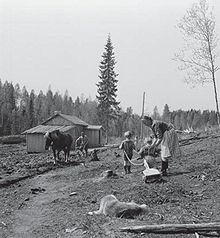
An evacuated Karelian family works on their new farm in southern Finland.
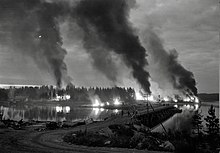
Finnish soldiers set fire to houses during their retreat in the summer of 1944 to prevent the enemy from using them.
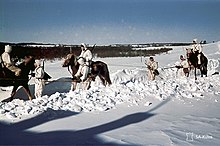
Finnish cavalry in Karelia, spring 1942.
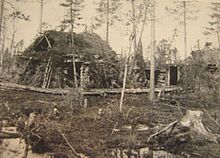
Camouflaged bunker of the German Wehrmacht near Rovaniemi
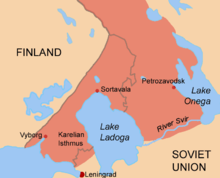
Situation at the beginning of December 1941 until June 1944.
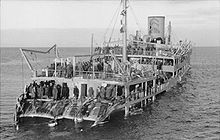
The Soviet troop carrier Josif Stalin, which had run onto a German mine barrage during the evacuation of the Hanko base in December 1941, was half sunk.
Search within the encyclopedia